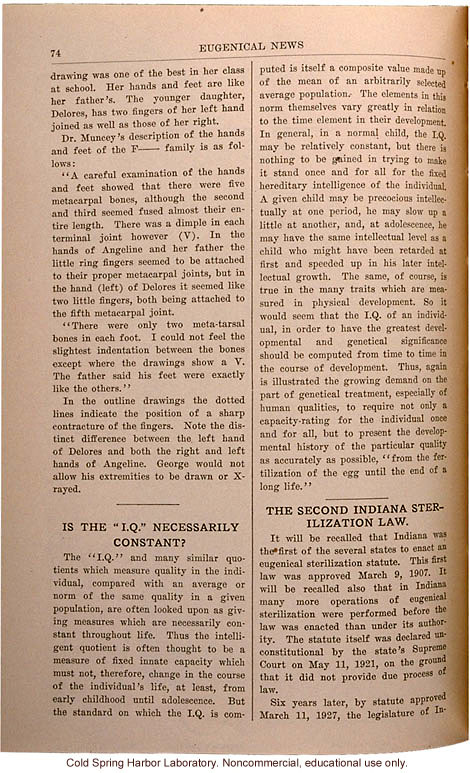74 Eugenical News
drawing was one of the best in her school. Her hands and feet are like her father's. The younger daughter, Delores, has two fingers of her left hand joined as well as those of her right.
Dr. Muncey's description of the hands and feet of the F--- family is as follows:
"A careful examination of the hands and feet showed that there were five metacarpal bones, although the second and third seemed fused almost their entire length. There was a dimple in each terminal joint however (V). In the hands of Angeline and her father the little ring fingers seemed to be attached to their proper metacarpal joints, but in the hand (left) of Delores it seemed like two little fingers, both being attached to the fifth metacarpal joint.
There were only two meta-tarsal bones in each foot. I could not feel the slightest indentation between the bones except where the drawings show a V. The father said his feet were exactly like the others."
In the outline drawings the dotted lines indicate the position of a sharp contracture of the fingers. Note the distinct difference between the left hand of Delores and both the right and left hands of Angeline. George would not allow his extremities to be drawn of X-rayed.
[centered score]
Is the I.Q. Necessarily Constant?
The "I.Q." and many similar quotients which measure quality in the individual, compared with an average or norm of the same quality in a given population, are often looked upon as giving measures which are necessarily constant throughout life. Thus the intelligent quotient is often thought to be a measure of fixed innate capacity which must not, therefore, change in the course of the individual's life, at least, from early childhood until adolescence. But the standard on which the I.Q. is computed is itself a composite value made up of the mean of an arbitrarily selected average population. The elements in this norm themselves vary greatly in relation to the time element in their development. In general, in a normal child, the I.Q. may be relatively constant, but there is nothing to be gained in trying to make it stand once and for all for the fixed hereditary intelligence of the individual. A given child may be precocious intellectually at one period, he may slow up a little at another, and, at adolescence, he may have the same intellectual level as a child who might have been retarded at first and speeded up in his later intellectual growth. The same, of course, is true in many traits which are measured in physical development. So it would seem that the I.Q. of an individual, in order to have the greatest developmental and genetical significance should be computed from time to time in the course of development. Thus, again is illustrated the growing demand on the part of genetical treatment, especially of human qualities, to require not only a capacity-rating for the individual once and for all, but to present the developmental history of the particular quality as accurately as possible, "from the fertilization of the egg until the end of a long life."
[centered score]
The Second Indiana Sterilization Law.
It will be recalled that Indiana was the first of several states to enact an eugenical sterilization statute. This first law was approved March 9, 1907. It will be recalled also that in Indiana many more operations of eugenical sterilization were performed before the law was enacted than under its authority. The statute itself was declared unconstitutional by the state's Supreme Court on May 11, 1921, on the ground that it did not provide due process of law.
Six years later, by statute approved March 11, 1927, the legislature of In-
[end]


